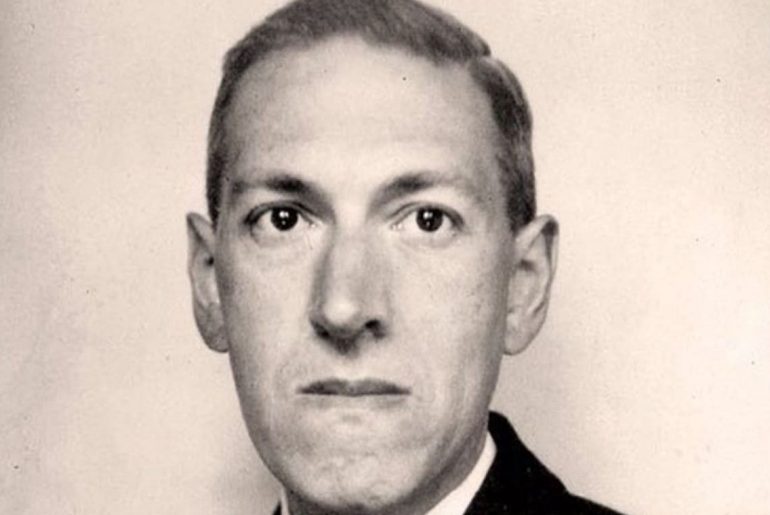(Providence, 1890 – 1937) American writer. Undisputed master of fantasy literature, his work actually goes beyond the confluence of genres such as horror literature and science fiction to crystallize in a unique narrative that recreates a terrifying mythology of beings from a parallel underworld. The nature landscapes of his native region, New England, influenced his fanciful and melancholic temperament. As a child he was trained in mythological readings, astronomy and science. In 1919 he read the work of Lord Dunsany, which marked him sensibly; the same thing happened with Edgar Allan Poe and Arthur Machen. Most of his works were published in Weird Tales magazine.
Considered one of the most brilliant and original authors of fantastic fiction of the 20th century, H. P. Lovecraft’s fame grew especially after his death, when his work, which initially appeared in specialized magazines, was published in volume. In his narrative, heterogeneous elements merge: the influence of Edgar Allan Poe, recognizable in certain atmospheres and technical resources of his juvenile stories, but also in mature novels such as In the mountains of madness (1931); the links with the tradition and the landscape of New England, dreamily transformed into a fantastic space; or the outbursts of science fiction, which are developed in stories such as The color that fell from space (1927).
The title of greatest originality of Lovecraft’s work, however, lies in the creation of a complex and personal monstrous mythology at the center of which are the old ones, horrible divinities expelled from Earth in prehistoric times and struggling to survive. take possession of it. These monstrous, foul-smelling beings appear first sporadically and then more and more organically in such short stories as The Rats in the Walls (1924), The Cthulhu Mythos (1926), and The Dunwich Horror (1927), and in novels such as The Case by Charles Dexter Ward (1927).
Such mythology gradually took shape; it was enriched by lesser divinities with different spheres of influence and sustained by recourse to cursed fictitious books, such as the Necromicon. Starting from gothic suggestions, through increasingly distressing nightmares, Lovecraft’s terror becomes cosmic, the extreme figure of his philosophical pessimism.
The rats in the walls (1924) is a masterful sample of his first works, in which the mythology of the sinister things that he continued to develop in his later stories and novels was only outlined. Delapore, an American of English descent, moved in 1923 to Exham Priory Castle, abandoned for centuries and restored according to its old plans. His ancestors had lived there at the time of James I, but several murders had later exterminated the entire lineage except for a single survivor: Walter de la Poer. Suspected of being the author of the murders, although it had not been proven, this last descendant emigrated to the colony of Virginia.
Delapore can only enjoy his property for a few days, since after a short time there are noises in the castle that sound like countless rats running behind the tapestries and wall coverings, which causes him and the servants a terrible restlessness. In the course of his investigations, he finds an ancient sacrificial stone in the basement, from which it seems that at the time of Roman domination in Brittany there was a place of worship for the divinities Attis and Cybele.
Along with his friend, Captain Norrys, and some London archaeologists, Delapore descends a few days later into the deepest crypts of the castle, where “scenes of unspeakable horror” await him: descending a staircase covered with gnawed bones, he arrives at a gigantic grotto and sees dwellings of all ages, from the beginning of humanity to the times of the Stuarts, where people of different ages had been imprisoned and reduced to a purely animal state, as victims of a cannibalistic cult of ancient times. antediluvians, or had become the prey of a “hungry, malignant, gelatinous army of rats”.
Delapore, suddenly separated from the group of investigators, is pushed by the rats “into the furthest caves, in the deepest bowels of the earth”, where “Nyarlahotep, the mad god without a face, blindly howls to the beat of two idiot flute players “. However, it is possible that this vision was instilled in him by his dazed and morbidly exaggerated fantasy about the monstrous discoveries, since when he comes to he finds out that he had been found near the half-devoured corpse of Norrys, babbling mysterious words: the “genius loci” , the lemurs from hell had managed to take him over (just as they had done with their ancestors before) and had turned him into a cannibal. And he is then able to understand the fate of Walter de la Poer as well: he had found out that the other members of the family participated in the bloody rites of the grotto, he had killed them and thus had been a benefactor for humanity.
As Lovecraft himself declared, all his stories are based on the legend that “this world had been inhabited in ancient times by another race, who was annihilated and expelled when exercising black magic, but who continue to live outside the world, being willing at all times to retake possession of this land”. In other stories it is about corpse-eating demons, who penetrate our rational world, being held – as for example in Pickman’s Model (1927) – by a painter in horrific portraits.
In The Music of Erich Zann (1925), the musician Zann is tormented by monsters “which live in indeterminate regions and dimensions outside our material universe”, and they inspire him at the same time for a beautiful violin piece. unreal. In La visita de Cthulhu (1928), whose action takes place on an island in the South Seas where there are some prehistoric cyclopean constructions, Cthulhu reappears for a short period of time, crouching inside the island. Earth. And in The Dunwich Horror (1929), an evil spirit of the most horrible kind grows in New England, and can only be destroyed by men “acquainted with the occult and forbidden sciences.”
Lovecraft varies his theme from horror with witty and highly suggestive fantasy; he is never short of figures of speech to characterize oppressive states of terror, places where imminent dangers loom, “full of black mucus, chewed up by mist,” or disgusting monstrosities “that stink like hell.” He continually introduces ambiguous references to the relationships of his mythology to the cult of voodoo, to Atlantis, the mysterious stones of Stonehenge and Easter Island, or the witch hunts in New England.
His stories, among whose ancestors we must naturally count Edgar Allan Poe, reveal the influence of the English authors of horror stories Arthur Machen and Lord Dunsany, but Lovecraft widens the regions of literary horror with quips entirely his own, with which he systematically staged a “Cthulhu mythology”. Lovecraft’s also theoretical interest in fantastic literature is attested to by his critical writings, in particular by The Horror in Literature (1927), in which he formulated a theory of the genre founded on psychological and formal bases. For the author, the stories of this genre must contain “some violation or overcoming of a fixed cosmic law, an imaginative escape from the tedious reality”.
Lovecraft’s stories and novels, despite being located on the limits of mythology and visionary fantasy, are plausible, because despite the author’s macabre instinct, a detailed, persuasive and slow prose organizes a small self-sufficient and credible world, even possessive for many readers. It has influenced modern authors such as Jorge Luis Borges, who drew on Lovecraft’s style to write a strange story included in The Book of Sand (1975).
Why is H.P. Lovecraft important?
“He was the first writer of supernatural literature to understand the psychological consequences of the generations of Puritanism and the warping of the human psyche that resulted.” Lovecraft’s influence on Moore lay in how the author was able to link the cosmic to the familiar.
What did H.P. Lovecraft suffer from?
He was diagnosed with cancer of the small intestine, and, ever the macabre-obsessed weirdo, kept meticulous notes of the various unpleasant ways his malady manifested itself. On March 15, 1937, ten years after moving back to Providence, Lovecraft passed away, his pain finally coming to an end.
What is Lovecraft most famous work?
The Call of Cthulhu is probably Lovecraft’s most influential story, serving as the basis for his epic “Old Ones” mythos. It centers around an ancient dragon-sea monster hybrid that implants itself subconsciously into human minds, driving them slowly insane.
Is H.P. Lovecraft still alive?
Date of death: March 15, 1937
Place of death: Providence, Rhode Island, United States





